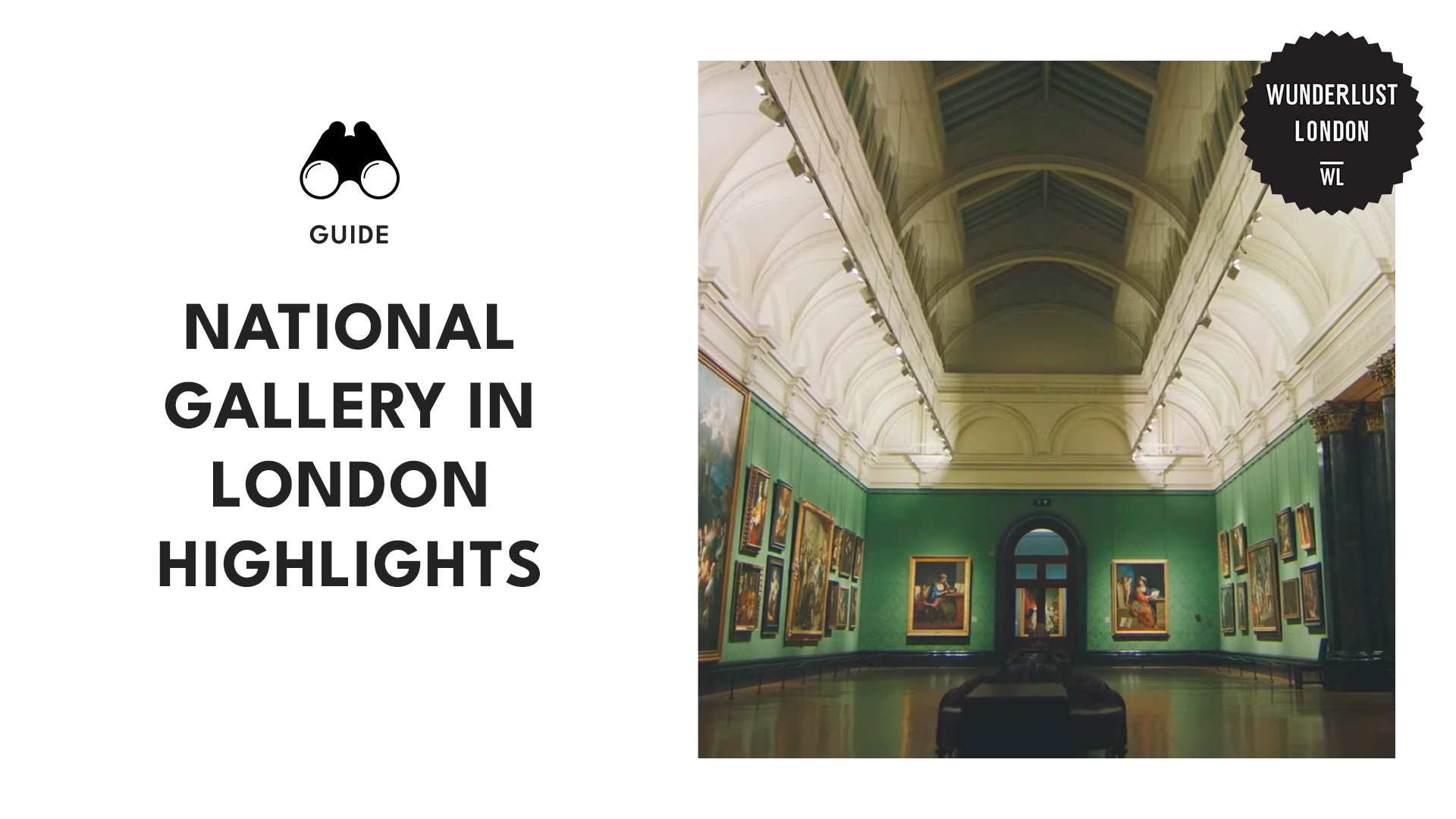The National Gallery in London, founded in 1824, is home to over 2,300 paintings spanning seven centuries of art history. It’s located in Trafalgar Square and is a cultural treasure offering free access to some of the world’s most iconic masterpieces.
Museums can feel overwhelming with so much to see, but some paintings simply stand out as exceptional highlights. Each piece holds its own magic, offering a window into the past and the minds of history’s greatest artists.
So grab a coffee from their gallery café and discover why the National Gallery is one of London’s finest gems!
The National Gallery
Website
Address: Trafalgar Square
Contact: [email protected] | +44 (0)20 7747 2885
Operating Hours: Monday–Sunday: 10:00–18:00 Friday extended hours: until 21:00
Admission: Free (except for special exhibitions)
1. The Arnolfini Portrait – Jan van Eyck (1434)
Media credit: markhughesart
Room: 15
The Arnolfini Portrait by Jan van Eyck left me reflecting on its artistry and what it says about human connection and the passing of time.
Seeing the painting in person, I was struck by the quiet intimacy of the scene—a couple standing together, surrounded by objects that seem ordinary at first glance but hold deeper meaning.
The mirror at the centre was what truly pulled me in. It reflects more than just the room—it hints at something beyond what’s visible. It’s almost like a reminder of how our lives are always connected to others, even those we don’t see.
The single candle, the dog, oranges are more than symbols of faith, loyalty, and wealth. They feel like pieces of life carefully constructed, just like we all create meaning in our own surroundings.
2. Sunflowers – Vincent van Gogh (1888)
Media credit: laurengrace22
Room: 43
Van Gogh’s Sunflowers (1888) is one of the most recognisable paintings in the world, and seeing it in person is unforgettable.
Created as part of a series, Van Gogh painted it to decorate a guest room in his Yellow House in Arles, where he hoped to build a community of artists. The vibrant yellows, bold brushstrokes, and different stages of the sunflowers—from blooming to withering—are captivating.
What struck me most was its raw honesty. The sunflowers, at different stages of bloom and decay, seem to symbolise the cycles of life.
The thick layers of paint give it texture and energy that no photo can capture. Standing before it, I couldn’t help but feel connected to the artist and his world.
3. The Fighting Temeraire – J.M.W. Turner (1839)
Media credit: theartdistricts
Room: 34
When I saw Turner’s The Fighting Temeraire (1839), I felt a quiet sense of nostalgia and loss. It shows the HMS Temeraire, once a heroic warship, being towed by a steam tugboat to be dismantled—a symbol of the end of an era.
The glowing sunset and the fading grandeur of the Temeraire reminded me that progress often requires letting go of the past, even when it’s something significant. It made me think about balancing moving forward while honouring what came before.
Looking at it, I realised how much life is about these transitions—letting go of what was and making space for what’s to come. It’s a painting about history but also a reminder that change is inevitable, and there’s beauty in that too.
4. The Ambassadors – Hans Holbein the Younger (1533)
Media credit: robertjwossant
Room: 12
Hans Holbein the Younger’s The Ambassadors (1533) is the painting that keeps revealing more the longer you look.
At first glance, it’s a grand portrait of two wealthy men surrounded by objects that reflect their knowledge and status—globes, instruments, and books. But as I stood before it, I noticed the peculiar shape at the bottom of the painting.
Tilting my head, the hidden anamorphic skull came into view—a haunting reminder of mortality amid all the symbols of wealth and learning.
This painting left me reflecting on how we balance the pursuit of achievement with the reality of our impermanence. It’s a masterpiece that speaks to both the intellect and the soul.
5. Virgin of the Rocks – Leonardo da Vinci (1491-1508)
Media credit: nationalgallery
Room: 66
Leonardo da Vinci’s Virgin of the Rocks (1491–1508) depicts the Virgin Mary, baby Jesus, John the Baptist, and an angel in a cave-like setting. The painting blends religious imagery with striking naturalism, making the figures appear lifelike and grounded in a real environment.
The interplay of light and shadow gives the painting depth, with the figures glowing softly against the dark background. The angel’s calm gaze and the gentle gestures of the figures create a sense of serenity, while the rocky landscape adds an air of mystery.
The painting highlights the connection between humanity and nature, combining faith with a sense of the natural world’s beauty. It left me reflecting on how Leonardo’s attention to detail and composition seamlessly and harmoniously combine the divine and the earthly.
6. Bacchus and Ariadne – Titian (1520-1523)
Media credit: arthistoryfeed
Room: 29
Titian’s Bacchus and Ariadne (1520–1523) depicts the moment Bacchus, the god of wine, falls in love with Ariadne, who has been abandoned on the island of Naxos. Bacchus leaps from his chariot towards her, while Ariadne appears startled and unsure.
The vivid colours, especially Ariadne’s blue dress and the rich reds and greens in the background, bring the mythological scene to life.
The painting captures the intensity of Bacchus’s passion and Ariadne’s heartbreak, creating a powerful contrast between love and loss. The constellation in the sky symbolises Ariadne’s eventual immortality, adding a layer of hope to the story.
This painting made me reflect on how emotions like love and heartbreak are timeless. Titian’s ability to vividly portray these feelings through movement, expression, and colour makes this work unforgettable.
7. Rokeby Venus – Diego Velázquez (1647-1651)
Media credit: paintfluence
Room: 30
Diego Velázquez’s The Rokeby Venus painting shows Venus (the goddess of love) reclining on a bed with her back to the viewer, gazing into a mirror held by Cupid.
This painting is the only surviving nude by Velázquez, and its subtle sensuality lies in the soft curves of Venus’s figure and the muted reflection in the mirror.
There’s nothing overly elaborate about it, yet it speaks volumes. The blurred face in the mirror made me think about how we see ourselves—sometimes clearly, sometimes distorted—and how much of what we perceive is shaped by perspective.
The portrayal of Venus is also about self-awareness and love, framed in a way that feels human rather than idealised. Velázquez captured something deeply relatable in this piece, and it stayed with me long after I left.
8. The Stonemason’s Yard – Canaletto (1725)
Media credit: 60sec_arthistory
Website
Room: 38
Canaletto’s The Stonemason’s Yard (1725) offers a unique look at everyday life in Venice. Instead of his usual grand views of canals and palaces, this painting focuses on a quiet, working-class corner of the city.
The scene shows workers cutting stones, children playing, and locals going about their day, surrounded by worn buildings and a calm canal in the background.
The level of detail is incredible—every crack in the walls, shadow on the ground, and reflection in the water feels carefully observed. It’s not a romanticised version of Venice but a glimpse into its real, lived-in side.
Seeing this painting made me appreciate the beauty of ordinary moments. Canaletto captures the rhythm of daily life, showing that even small, everyday scenes can tell a powerful story.
9. Bathers at Asnières – Georges Seurat (1884)
Media credit: lets_talk_about_art
Room: 43
Georges Seurat’s Bathers at Asnières is a serene depiction of a summer day by the River Seine. Painted in 1884, it captures a group of working-class men and boys taking a break to enjoy the water and sunshine.
The composition is calm and carefully arranged. It showcases Seurat’s signature pointillism technique, giving the painting a luminous and almost dreamlike quality.
Despite being full of life, I was struck by how peaceful it still feels. The figures don’t interact much, but their quiet presence creates a sense of shared tranquillity. The soft, dappled light and carefully balanced colours make the scene timeless and familiar.
Seurat’s attention to detail transforms an ordinary riverside scene into something extraordinary—a reminder of the beauty in simple, everyday moments.
10. Bathers at La Grenouillère – Claude Monet (1869)
Media credit: claude._.monet
Room: 44
Claude Monet’s Bathers at La Grenouillère (1869) captures a lively yet peaceful day by the Seine. The painting shows bathers and boaters gathered around a floating café, a popular riverside spot near Paris.
Using his signature Impressionist style, Monet’s quick brushstrokes and focus on light and movement bring the scene to life. The shimmering reflections on the water seem to ripple with colour, making the painting feel full of energy and warmth.
Looking at it, I thought about the joy of simple moments—spending time outdoors, enjoying nature, and connecting with others. It’s a beautiful reminder of the charm found in everyday life, captured with Monet’s incredible talent.
11. Samson and Delilah – Peter Paul Rubens (1610)
Media credit: nationalgallery
Room: 18
Peter Paul Rubens’ Samson and Delilah (1609–1610) shows Samson, vulnerable and asleep on Delilah’s lap. There’s a servant quietly cutting his hair, stealing his strength.
The dim lighting, vivid colours, and rich textures make the scene feel both intimate and tense, almost as if you’re witnessing the betrayal unfold in real time.
What drew me in was Delilah’s expression—calm yet calculating. The contrast between her composed demeanour and Samson’s complete vulnerability felt almost heartbreaking.
The glowing candlelight added to the secrecy, illuminating the scene enough to heighten the drama without breaking its intimacy.
Looking at this painting, I couldn’t help but reflect on the fragility of trust. Rubens captures a biblical story and a deeply human moment of betrayal and loss.
12. Surprised! – Henri Rousseau (1891)
Media credit: lets_talk_about_art
Room: 41
Henri Rousseau’s Surprised! (1891) captures a tiger creeping through tall grass during a storm, its sharp teeth and wide eyes blending innocence with ferocity.
Dark clouds and flashes of lightning in the background add energy and tension, making the jungle scene feel alive and full of movement.
The bold colours and simplified shapes give the painting a storybook-like quality, making it perfect for children and anyone with a vivid imagination. It feels like a scene from a tale, sparking curiosity about what happens next in this world.
This painting made me reflect on nature’s raw beauty and unpredictability. Rousseau’s unique style creates playful and intense moments. It’s the artwork that stays with you, no matter your age.
13. Lady Standing at a Virginal – Johannes Vermeer (1670)
Media credit: fineartcatalog
Room: 16
Johannes Vermeer’s A Young Woman Standing at a Virginal (1670–1672) is a beautifully quiet painting that feels like a peaceful moment. It shows a woman playing a virginal, surrounded by soft light that highlights the delicate textures of her clothing and the instrument.
Behind her, a painting of Cupid hangs on the wall. A faint reflection of a landscape can be seen on the virginal, adding subtle details to the scene. Everything about the painting feels calm and introspective, as if time has slowed down.
Seeing it in person, I was struck by how soothing it felt. The soft light, gentle colours, and serene expression of the woman made me reflect on the simple joy of music and the moments of peace it can bring.







